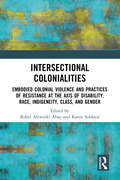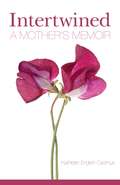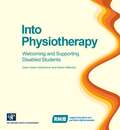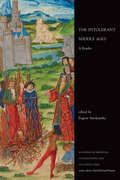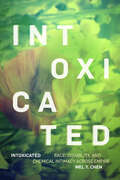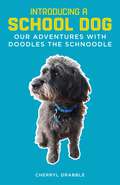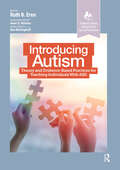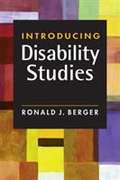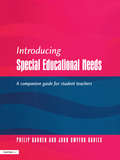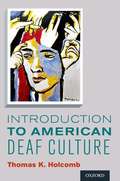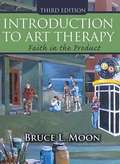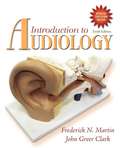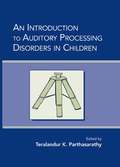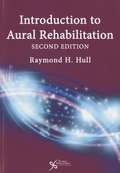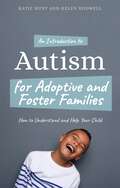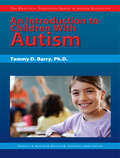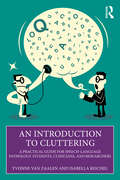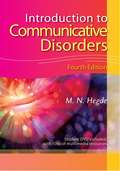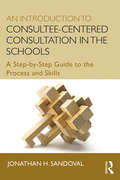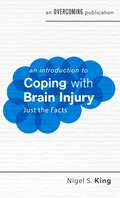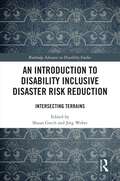- Table View
- List View
Intersectional Colonialities: Embodied Colonial Violence and Practices of Resistance at the Axis of Disability, Race, Indigeneity, Class, and Gender (Interdisciplinary Disability Studies)
by Karen Soldatić Robel Afeworki AbayThis book provides a rich synthesis of empirical research and theoretical engagements with questions of disability across different practices of colonialism as historically defined – post/de/anti/settler colonialism.It synthesises, critiques, and expands the boundaries of existing disability research which has been undertaken within different colonial contexts through the rich examination of recent empirical work mapping across disability and its intersectional colonialities. Filling an existing gap within the international literature through embedding the importance of grounding these within scholarly debates of colonialism, it empirically demonstrates the significance of disability for the broader scholarly fields of postcolonial, decolonial, and intersectional theories.It will be of interest to all scholars and students of disability studies, sociology, critical studies, sociology of race and ethic relations, intersectionality, postcolonial and decolonial studies, and human geography.
Intersectional Insights: Disability, Gender and The Path To Inclusion
by Jalasa Sapkota"Intersectional Insights: Disability, Gender, and the Path to Inclusion" by Jalasa Sapkota is a thought-provoking compilation diving into the intersectionality of disability and gender, focusing on the challenges and solutions for inclusive societal integration. Divided into three chapters, the book covers diverse aspects. In Chapter 1, "Education," Sapkota examines the hurdles in achieving inclusive education in Nepal and advocates for authentic portrayals of disabilities in media. Chapter 2, "Politics and Movement," highlights the need for inclusive strategies in Nepali politics, links broader human rights issues with disability rights, and explores the role of youth movements in empowerment. The final chapter, "Sexuality and Empowerment," delves into comprehensive sexual education for women with disabilities and advocates for inclusive participation in cultural celebrations. Sapkota's insightful and accessible writing offers practical solutions, making this compilation a valuable resource for those interested in disability rights, gender, and fostering social inclusion.
Intertwined: A Mother's Memoir
by Kathleen English Cadmus“…A heartfelt, brave, raw, yet hopeful journey of a mother’s loss and unconditional love.” - Shannon Hudson Johnson, Psy.D., clinical psychologistHow does a woman go from being a normal Midwestern mom to sitting across the table from a bounty hunter? That’s what Kathleen English Cadmus wondered as she took one more surreal step in her quest to find and save her teenage daughter, Laura.The beautiful baby Kathleen had adopted from Korea was on the run again, fueled by another manic episode brought on by her bipolar disorder.Having already lost her son Shawn to a tragic accident, Kathleen couldn’t bear the thought that she had failed to protect another one of her children.Intertwined: A Mother’s Memoir is a raw but loving tribute to the pain and beauty of motherhood—the story of a mother, a daughter, a son, two marriages, and the way all of those lives are at once distinct yet inseparable. Intertwined illustrates the way the people we love become part of us—become us—and show us who we truly are.
Into Physiotherapy
by Jane Owen Hutchinson Karen AtkinsonBecoming a physiotherapist remains an inspiring goal for many people. Whilst physiotherapy has, for many years, been recognised as an excellent career option for visually impaired people, increasingly those with a range of visual and other disabilities have successfully completed qualifying programmes. By reflecting the diversity present within the patient population, the presence of disabled staff enhances the quality of health-care services. Recognising, in particular, the need for guidance for staff involved in providing practice education, the CSP published the document.
The Intolerant Middle Ages: A Reader (Readings in Medieval Civilizations and Cultures)
The Intolerant Middle Ages is a collection of primary sources on the history of persecution. The goal of the book is to highlight instances of persecution and violence, as well as those relatively rare but significant episodes of toleration, toward an intentionally broad spectrum of people who existed at the margins of medieval society: heretics, Jews and Muslims, the poor, the displaced and disabled, women, and those deemed sexually deviant. The volume also presents a more geographically diverse Middle Ages by including sources from Central and Eastern Europe as well as the Mediterranean. Sources are organized in thematic chapters, covering everything from "Heresy and Inquisition" to "Disease and Disability." Each document is preceded by a brief introduction and followed by questions for discussion, making The Intolerant Middle Ages an excellent entrance into the lives and struggles of minorities in the medieval world.
Intoxicated: Race, Disability, and Chemical Intimacy across Empire (ANIMA: Critical Race Studies Otherwise)
by Mel Y. ChenIn Intoxicated Mel Y. Chen explores the ongoing imperial relationship between race, sexuality, and disability. They focus on nineteenth-century biopolitical archives in England and Australia to show how mutual entanglements of race and disability take form through toxicity. Examining English scientist John Langdon Down’s characterization of white intellectual disability as Asian interiority and Queensland’s racialization and targeting of Aboriginal peoples through its ostensible concern with black opium, Chen explores how the colonial administration of race and disability gives rise to “intoxicated” subjects often shadowed by slowness. Chen charts the ongoing reverberations of these chemical entanglements in art and contemporary moments of political and economic conflict or agitation. Although intoxicated subjects may be affected by ongoing pollution or discredited as agents of failure, Chen affirmatively identifies queer/crip forms of unlearning and worldmaking under imperialism. Exemplifying an undisciplined thinking that resists linear or accretive methods of inquiry, Chen unsettles conventional understandings of slowness and agitation, intellectual method, and the toxic ordinary.
Introducing a School Dog: Our Adventures with Doodles the Schnoodle
by Cherryl DrabbleAnimal Assisted Therapy is becoming increasingly popular in education settings, but there is very little information on how to implement it. This practical guide provides everything you need to know to introduce a therapy dog, and the various benefits that a dog can have for pupils, from young children to teenagers.
Introducing Autism: Theory and Evidence-Based Practices for Teaching Individuals with ASD (Evidence-Based Instruction in Special Education)
by Ruth ErenWritten by educators for educators, Introducing Autism: Theory and Evidence-Based Practices for Teaching Individuals With ASD is an introductory text offering a broad picture of Autism Spectrum Disorder for students, teachers, related service providers, and other school personnel who are engaged in the education of individuals with ASD.Introducing Autism imparts knowledge and understanding of the broad spectrum of ASD and suggests evidence-based practices to support this population. Editor Dr. Ruth Eren and the text contributors provide readers with a firm foundation of facts, strategies, and processes that help explain and address the complex profile of an individual with ASD. As a result of this understanding, current and future practitioners will be equipped with the skills and strategies to work collaboratively and effectively with their school team as they create a program for a student on the spectrum.What’s included in Introducing Autism: Content supported by case studies based in authentic educational settings Evidence-based practices suggested for use in the classroom Voices from the Spectrum sections in each chapter which feature the viewpoints from individuals on the spectrum Introducing Autism: Theory and Evidence-Based Practices for Teaching Individuals With ASD will enable universities to offer a comprehensive course that provides a strong foundation of knowledge and understanding of ASD to prepare teachers and related service providers for certification.
Introducing Disability Studies
by Ronald BergerRonald Berger provides students with a comprehensive, accessible introduction to the key themes and controversies in disability studies. This innovative textbook: • provides historical context, from ancient times to the present • traces disability's impact throughout the life course • gives prominence to the voices of people with disabilities • explores popular culture’s role in distorting ideas about disability • addresses emerging ethical issues, such as the implications of genetic selection. Illustrating the profound consequences of differing conceptions of physical, sensory, and cognitive impairments, Berger provides a solid foundation for making sense of disability as a social phenomenon.
Introducing Special Educational Needs: A Guide for Students
by Philip Gardner John Dwyfor DaviesPressure of time means that the complex topic of special educational needs (SEN) at initial teacher training and post-graduate levels can often be covered at too swift a pace. The unfortunate result is that a newly qualified teacher faced with the pressures of today's typically inclusive classrooms can feel unprepared or lacking in knowledge about this vitally important area.This supportive, accessible text will be invaluable to students undergoing their initial teacher training as it features broad coverage of key aspects of SEN in a single volume. It will provide the reader with succinct information on major SEN themes, key questions for student teachers on each topic, and a selection of the most important readings. It also includes sets of reflection-based student tasks; activities for completion during school placements; practical tutor-led to mentor-led activities, plus extension activities; and a series of suggested topics for school-based assignments in SEN.
Introduction to American Deaf Culture (Professional Perspectives on Deafness: Evidence and Applications)
by Thomas K. HolcombIntroduction to American Deaf Culture is the only comprehensive textbook that provides a broad, yet in-depth, exploration of how Deaf people are best understood from a cultural perspective, with coverage of topics such as how culture is defined, how the concept of culture can be applied to the Deaf experience, and how Deaf culture has evolved over the years. Among the issues included are an analysis of various segments of the Deaf community, Deaf cultural norms, the tension between the Deaf and disabled communities, Deaf art and literature (both written English and ASL forms), the solutions being offered by the Deaf community for effective living as Deaf individuals, and an analysis of the universality of the Deaf experience, including the enculturation process that many Deaf people undergo as they develop healthy identities. <p><p> As a member of a multigenerational Deaf family with a lifetime of experience living bi-culturally among Deaf and hearing people, author Thomas K. Holcomb enhances the text with engaging stories interwoven throughout. In addition to being used in college-level courses, this book can also help parents and educators of Deaf children understand the world of Deaf culture. It offers a beautiful introduction to the ways Deaf people effectively manage their lives in a world full of people who can hear.
Introduction to Art Therapy: Faith in the Product
by Bruce L. MoonThis book describes the essential elements of the process of facilitating therapeutic change in forming a foundation from which art therapists construct treatment plans and philosophies. Enhancements in this text include: an overview of the spectrum of theoretical orientations within art therapy; a brief history of practice in the United States; descriptions of applications that were not widely understood in 1994; and the most current and seasoned interpretation of how the author perceives the art therapy experience. In addition, the author presents exceptional case examples including client-prepared artwork that highlights the text. This book will inspire serious artists to become involved in art therapy, and encourage veteran art therapists to renew their vocations by living the process of art therapy. This book will be a valuable resource to medical and mental health professionals, occupational therapists, and other rehabilitation professionals that aspire to become more effective in reaching others.
Introduction to Audiology (10th edition)
by Frederick N. Martin John Greer ClarkThe ninth edition of Martin's (U. of Texas at Austin) and Clark's (U. of Cincinnati) textbook features updated material throughout the text, including more detailed discussions of recent objective measures; new material on licensing/certification, outcome measures, and evidence-based practice; a revised discussion of the rapidly evolving measures of auditory evoked potentials; and separate discussions of pediatric and adult hearing aid selection/verification and hearing loss management.
An Introduction to Auditory Processing Disorders in Children
by Teralandur K. ParthasarathyAuditory processing in children (APD) comprises an increasingly important clinical area within the broad field of communication disorders. This new textbook presents the major advances in the assessment and management of APD. The chapter authors, highly regarded clinicians and researchers from diverse professional groups, contribute an impressive breadth of knowledge to explain and demystify APD. This text will be useful to students of speech language pathology and audiology, as well as professionals in those fields.
Introduction to Aural Rehabilitation (Second Edition)
by Raymond H. HullNow in its second edition, Introduction to Aural Rehabilitation continues to provide all the elements necessary for a comprehensive, practice-oriented course in the habilitation/rehabilitation of children, adults, and the elderly with impaired hearing. This user-friendly text focuses on the most important clinical and practical aspects of providing services to the hearing impaired, while avoiding the technical detail of theoretical texts. . This second edition offers more in-depth information on cochlear implantation-including surgical procedures as well as the benefits for children and adults-and is approached from an amplification standpoint across several chapters by new contributing authors. . New and expanded information for Introduction to Aural Rehabilitation, Second Edition, includes the following topics: Speech development for children with impaired hearing; Listening and language development for children with impaired hearing; Hearing aids and non-hearing aid assistive listening devices; Hearing aids for children with impaired hearing; Educational management of children with impaired hearing; Non-hearing assistive listening devices for adults; Physiology and psycho-social impact of hearing loss in older adulthood; Rehabilitation procedures for adults with impaired hearing; and Expanded appendixes on communication scales and questionnaires
An Introduction to Autism for Adoptive and Foster Families: How to Understand and Help Your Child
by Katie Hunt Helen RodwellWritten for busy foster carers and adoptive parents, this book provides a concise introduction to Autism Spectrum Disorder (ASD), and how to support a child with a diagnosis. It emphasises the common strengths children with ASD have, as well as offering strategies for any behavioural issues that are likely to arise, highlighting how these can be exacerbated by the care system and adoption process.The first part of the book looks at the different aspects of autism and the challenges it can pose for children and parents, providing strategies for managing difficulties at home and at school, using social stories, and reducing sensory input in a child's environment. The second part looks at issues that arise for fostered or adopted children, including placement transitions, contact, and explaining the past. It concludes with helping parents to think about self-care.
An Introduction to Children With Autism
by Tammy D. BarryThis new series offers timesaving books on critical topics for educating students with autism spectrum disorders. The four books in this series are filled with practical information and advice, thus making them an ideal resource for classroom teachers, preservice teachers, and graduate students. This introductory text in the series provides an overview of the characteristics of children with autism, the symptoms associated with autism, and the general nature of autism. An explanation of the autism spectrum and the culture of autism also are presented.
An Introduction to Cluttering: A Practical Guide for Speech-Language Pathology Students, Clinicians, and Researchers
by Yvonne van Zaalen Isabella ReichelAn Introduction to Cluttering explores the speech disorder of cluttering, offering concrete, evidence-based methods for its diagnosis and treatment.Cluttering is a globally recognized communication disorder, yet it is often poorly understood. This book presents a historical overview of the efforts of pioneers in the field to demystify the cluttering disorder, before introducing the aetiology and symptoms of cluttering from several perspectives: physiological, psycho-linguistic, neurological, social, affective, and cognitive. It also provides an in-depth discussion of the identification, differential diagnosis, and assessment of cluttering, using current and advanced diagnostic procedures before explaining the rationales and unique, innovative procedures for evidence-based treatments of cluttering. Engaging practical examples and theory boxes are featured throughout the book.Providing effective and user-friendly procedures for cluttering diagnosis and intervention, this book is an essential read for all current and future speech and language therapists.
Introduction to Communicative Disorders (4th edition)
by M. N. HegdeIn this update of the 2001, 1995, and 1991 editions, Hegde (communication sciences and disorders, California State U. , Fresno) introduces the rapidly growing science of communication and profession of communicative disorders. Coverage includes a new chapter on literacy skills in children and the role of the speech-language pathologist in literacy intervention; profiles of speech-language pathologists and audiologists; and expanded material on audiology, audiology rehabilitation, and disorders of swallowing. The text includes study questions; information on professional education, organizations, and standards; a glossary.
An Introduction to Consultee-Centered Consultation in the Schools: A Step-by-Step Guide to the Process and Skills (Consultation, Supervision, and Professional Learning in School Psychology Series)
by Jonathan H. SandovalDrawing on historical writings about mental health consultation and on contemporary research and theory, Jonathan Sandoval lucidly explains the consultee-centered approach to consultation. The book provides an expert foundation on which to build a training program for future school-based consultants. Written for graduate students in school psychology, counseling psychology, special education, and social work, this book is an invaluable resource for mental health professionals working in schools who wish to upgrade their professional skills and grow as reflective practitioners. Individual chapters describe different stages in the consultation process; outline the processes characterized in each stage; detail useful consultant skills; review pertinent research; discuss the ethical principles underlying practice; and suggest self-monitoring questions for student consultants. Featuring a step-by-step developmental model of the consultee-centered consultation process, this book encourages consultants to prioritize those characteristics that contribute to a consultee’s work difficulty, in addition to assessing the client more generally. By detailing this unique approach, this concise volume provides an applicable, contextualized, and strategic form of consultation, and fosters a professional-to-professional relationship distinguishable from supervision, counseling, therapy, coaching or other methods.
Introduction to Contemporary Special Education: New Horizons
by Deborah Smith Naomi Tyler Kimberly SkowIntroduction to Contemporary Special Education: New Horizons presents an introduction to the professional practices, trends, and research that define contemporary special education while also conveying the diversity and excitement of this changing field.
An Introduction to Coping with Brain Injury (An Introduction to Coping series)
by Nigel S. KingJust the facts for coping with the after-effects of a brain injuryAcquired Brain Injury (ABI) usually refers to people who have suffered a head injury or stroke but also includes those who have had brain tumours, an anoxic injury (where the brain has been starved of oxygen) or brain illnesses like encephalitis and meningitis. After an ABI, the brain undergoes a very slow healing process before improvements slow down and eventually plateau. This is different to other forms of brain conditions where the journey is more of a deteriorating one over time.ABI is commonly called 'a hidden disability' as it can easily be missed or misunderstood by others. Also it can significantly affect those close to the person and therefore it is frequently called 'a family affair' too. As the issues are often hidden, complicated and affect patients and families alike, this book can act as a roadmap to help you and your loved ones navigate through the complex and often unexpected challenges that can arise following a brain injury, using:- Cognitive rehabilitation approaches to understand and manage changes in our thinking abilities- Cognitive behavioural approaches to address ways in which our thoughts, feelings, actions and physical reactions relate to each other
An Introduction to Coping with Brain Injury (An Introduction to Coping series)
by Nigel S. KingJust the facts for coping with the after-effects of a brain injuryAcquired Brain Injury (ABI) usually refers to people who have suffered a head injury or stroke but also includes those who have had brain tumours, an anoxic injury (where the brain has been starved of oxygen) or brain illnesses like encephalitis and meningitis. After an ABI, the brain undergoes a very slow healing process before improvements slow down and eventually plateau. This is different to other forms of brain conditions where the journey is more of a deteriorating one over time.ABI is commonly called 'a hidden disability' as it can easily be missed or misunderstood by others. Also it can significantly affect those close to the person and therefore it is frequently called 'a family affair' too. As the issues are often hidden, complicated and affect patients and families alike, this book can act as a roadmap to help you and your loved ones navigate through the complex and often unexpected challenges that can arise following a brain injury, using:- Cognitive rehabilitation approaches to understand and manage changes in our thinking abilities- Cognitive behavioural approaches to address ways in which our thoughts, feelings, actions and physical reactions relate to each other
An Introduction to Disability Inclusive Disaster Risk Reduction: Intersecting Terrains (Routledge Advances in Disability Studies)
by Shaun Grech Jörg WeberThis first of its kind volume introduces Disability Inclusive Disaster Risk Reduction (DIDRR) in unprecedented critical and interdisciplinary ways covering the complex conceptual, theoretical and practice terrain. Established and emerging scholars and practitioners introduce and probe key discourses, theory, policy and practice at the intersections of disability, disasters and disaster risk reduction, navigating compound and dynamic areas including climate change, governance, wars and conflict, forced migration, disability representation, geopolitics, gender and ethnicity. This edited book lays out and questions established policies, discourses and practices in mainstream areas including Disaster Risk Reduction, Disaster Risk Management and Humanitarian Action, opening an effective critical debate to understand, challenge and shift dominant paradigms. By developing new theory on DIDRR, it will serve as an important tool for academics, researchers and practitioners working in multiple fields including disability studies, disaster management, global health, humanitarian studies, international studies and geography among others.
Introduction to Disability Studies
by David JohnstoneAn introductory text that explores the current issues in the lives and circumstances of disabled people, their careers, and those who intend to work in the caring services. Explores and analyzes quality of life factors, the emergence of rights, and the strengths and weakness of community care provisions. Also provides examples of individual oppressions and success stories, and suggests how disabled and non-disabled people can collaborate in the development of inclusive communities and neighborhoods. Distributed by Taylor & Francis. Annotation c. by Book News, Inc., Portland, OR.
